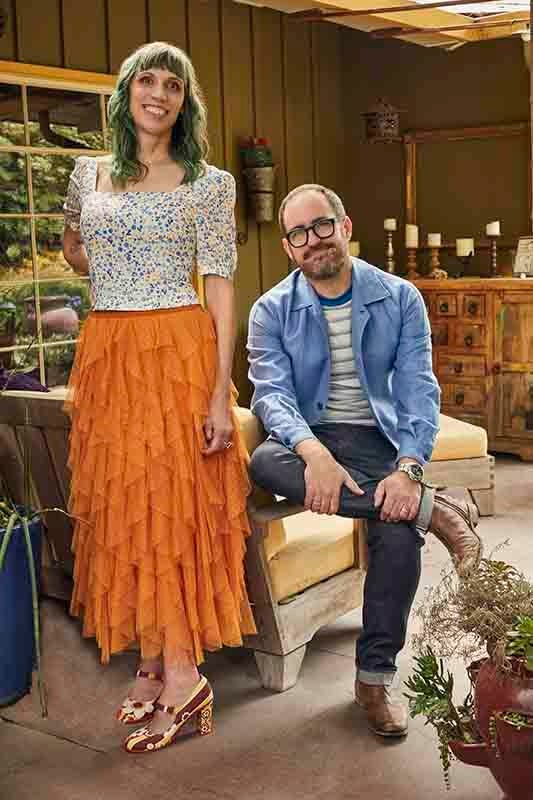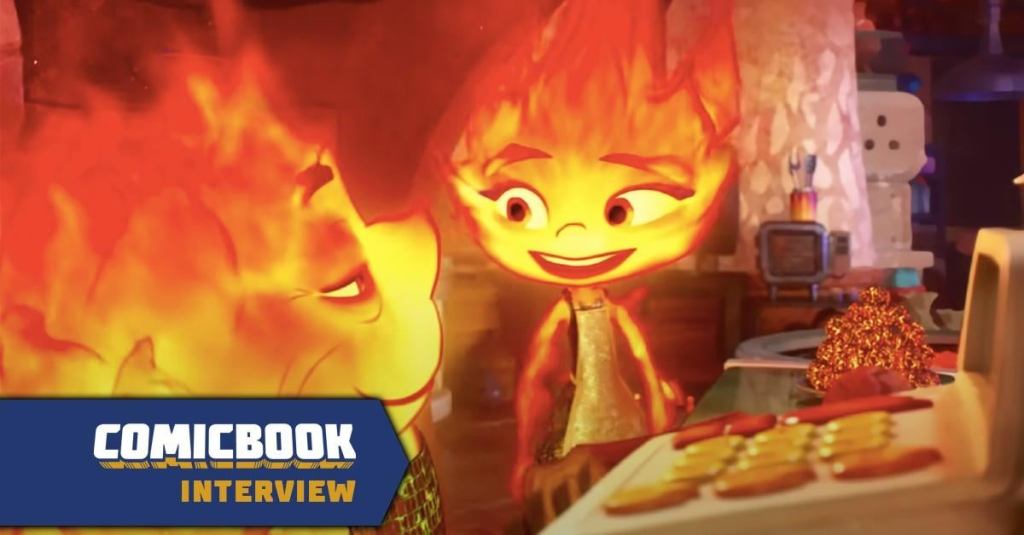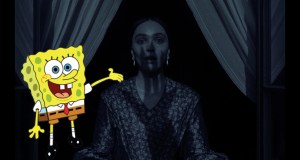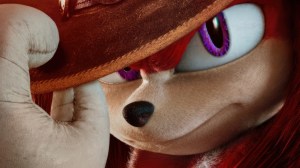Pixar Animation Studios’ latest film, Elemental, is now in theaters, telling the story of Ember (Leah Lewis), a short-tempered fire person and the more go-with-the-flow water person Wade (Mamoudou Athie) who begin to discover that while all the elements in Element City are different, they have a lot in common as well. The film is very much a rom-com, but it’s also a story with other layers as well: a story about family, about self, and about finding your own path while still honoring the one that came before you.
Videos by ComicBook.com
ComicBook.com recently sat down with writers Kat Likkel and John Hoberg to talk about how they not only got involved with Elemental, but how they helped craft this multifaceted story, drawing on their own experiences to create a tale that has such wide appeal.
Nicole Drum, ComicBook.com: how did you guys come to be involved with Elemental?
Kat Likkel: You know, working with Pixar is working with the Secret Service. You’re suddenly tapped on the shoulder and they’re like, “We’d like to meet with you.” And I think it actually initially started with Dan Fogelman, who’s a friend of ours who wrote Cars. And at one point a few years ago … 2012 [when we were working on Dan Fogelman’s] The Neighbors, we saw him on set one day and he went, “Oh, by the way, I just want you to know that Pixar gave me a call to ask about you guys.” And we were like, “Oh wow, that’s interesting.” And that was in 2012. And he’s like, “Pixar is weird. You may hear from them, you may not.” And so, it’s like we totally forgot about it until suddenly we got a call.
John Hoberg: Yeah, in 2019 we went to the Austin Film Festival and we were on a couple panels, and we got a call from our manager saying that … It was Mary Coleman who was the head of finding writers at the time, and she wanted to have a meeting, like a breakfast meeting. And we showed up and it was her and a woman, Megan, who’s at Pixar. And they had a stack of scripts, they had pulled a bunch of stuff and they’d read everything. And it was like, “Oh wow, this is a serious meeting. This isn’t just a meet and greet coffee.” And we had a great meeting. And then they were talking about how they’d love to work with us and maybe we’d have to move to the Bay Area if you do it. Would we do that? And we’re like, “Yes.” And they said, “Well, we might have a job opening in a week, it might not come for years, but you’re in our minds now.”
And about two or three weeks later we got a call that Pete Sohn wanted to meet. And we weren’t allowed to know what the movie was, we weren’t allowed to know anything. And they sent a car at 7 in the morning. You get on a plane, you show up there, you’re whisked off to the studio, you get a quick tour. And then we had an hour and a half lunch with Pete, still not knowing what the movie was. And looking back, he was asking us lots of questions about our family and really about our relationship, because we’re obviously married, and our relationship looking back in relation to Wade and Ember in a lot of ways. And then a couple weeks after that we found out that they wanted to hire us. It was just pure chance. It was unbelievable.
So, after you got brought onto it, what was the process like with this story? I’m a sucker for a good rom-com. but I also kept noticing there’s elements of a heist film in here, sort of. There’s almost a coming-of-age drama going on here, there’s other elements to it. And I know those things don’t just happen. There’s a process that goes into it. So, walk me through the process of developing this. Definitely not a straightforward rom-com. There’s layers, just like an onion, there’s layers.
John: One of the things that we talked a lot was, what is Ember’s want? Which is so key when you’re coming up with one of these stories. And it took a little bit to really get it down to super simple words, in a way. And what Ember wants is to be a good daughter. At her core she wants to be a good daughter. And the obstacle to getting there is Ember. And at first, she thinks the obstacle’s her temper, but then it’s revealed that actually the obstacle is, she wants to be a good daughter but she doesn’t want to do the thing that she thinks is the only way to be a good daughter. So, while I think it’s a great question ’cause you’re dead on, which is, yeah, it is, it’s got romantic elements, but it’s not like, “I want to find love,” which to me is a straight romantic comedy. That’s a straight story, is, “I’m looking for a partner.”
And this is really, she grows with Wade to discover who she really is. And so, they are kind of on a buddy comedy journey in a way that becomes romantic. And there is a little heist vibe to it and there is an action vibe to it. And that was, through the development you do so many versions. I think they had done three before we showed up, and then we came in and I think we did eight versions. And they were all trying different ways to find that balance that you’re pointing out.

Kat: Which is not unusual for Pixar, honestly. Their iterative process, which is such an amazing way to do a film. And Pixar has the luxury to do it. I think not every studio has the luxury to be able to do that kind of thing, but it’s one of the things that makes Pixar films so good.
John: But one of the things that Pete was saying earlier when we got there is, he’s like, “Yeah, it’s a romantic story where I’m looking for the Wade and Ember love story.” But he kept saying, “But in some ways I want it to be a love triangle between a dad, she’s choosing between a dad and this boyfriend.” And one of the biggest challenges, how do you make the dad … The easier move would be to make the dad a bad guy and he actively wants to shut down this romance. And so, we all worked really hard. There is no villain, although Bernie is, he’s an antagonist, but he’s out of the best of intentions.
Kat: He’s the obstacle. He’s the obstacle but not the villain.
John: Yeah. And so that was one of the things that we really had to work out a little bit. Because Pete really wanted to, rightfully, it was like the more we talked about his relationship with his dad, his dad was just such a lovely man. And it felt like, how do you show family pressure from someone who means it well, who’s actually dealing with their own trauma with their own parent because they feel like they haven’t lived up to what they’re meaning to do? But then while trying to break free of that, somehow, they’re imposing it on their daughter. So, it gets very complicated in a way, and a very good way.
So that was a lot of the working it out. And the last thing I’ll say, Kat, I don’t mean to monopolize here, is there was this question of, is it a romance or is it an immigration story? And at one point someone said in this process, “Look, it’s either/or.” And Pete’s response was, “But when you’re second generation and you feel this responsibility to carry on when your parents have sacrificed, there is no either/or. Everything is part of that.” And I think that was what was really important for him to get across.
Absolutely. One thing I also thought was interesting, because it is very much an immigration story and it’s a first gen kind of story. But something I thought was interesting watching it is that it works on other sort of “first gen” levels — I know personally for me, I am a first gen in the fact that I am the first person to leave my family’s rural community. I am the first person to go to college. I’m definitely the first person to get an advanced degree. And I think capturing that, there’s a lot of generational trauma that goes into that. How did you guys dig into that in a way that didn’t present that as a villainous situation?
Kat: Yeah. I think I had a not dissimilar situation. My family is Dutch and they came, my grandfather came here. And so, my parents, my grandfathers on both sides came here, and so my parents were born in the US but they grew up there in a very strong immigrant community. And so, they brought a lot of that to me and my family. And it’s a struggle when you have a generation that thinks differently about so many things, and I think thinks protectively. Because it’s like you’ve left one place that might have been unstable or there was no economic opportunity, whatever it is, and come to another place that, when you arrive at a new place, it’s equally precarious because you have to build up everything from scratch. And so, I think you become very protective. This is what I saw in my parents, at least.
They became very protective of who they wanted us to be and what they felt was going to be best for us. And believe me, when I decided that I wanted to go into the creative arts, that I wanted to be a writer, my family was … My mother one time in tears called me up and said, “I will pay for you to go back to college if you will just give up this writing thing.” And it was the hardest thing in the world to say no. And I think no matter who you are, whether you are an immigrant or your family has been here since time immemorial, those kind of disagreements with what we want for ourselves and what our parents want for us is relatable, whether it’s about this specific issue or not.
John: Kat, you talking about that reminded me of something your mom said at one point, which is, and she was in her 70s when she was like, “You know what? I finally decided that the voice of my dad judging me or my kids, I’m finally getting rid of that.” And it took her into her 70s to not feel like she was trying to live up to the expectation that her long deceased father had for her life. And we had a lot of talks like that with the story team when coming up with this, where it was sort of like, wow, we unintentionally carry on all of these burdens and things we’re trying to live up to. And then we pass them along. And I think one of the thoughts was, how can a whole family heal from that one trauma? So that became the north star, I think, at a certain point when we figured out the ending of the movie.
On the flip side of things, there’s Wade. He cries all the time and I love him for that. But how as writers, I feel like that’s got to be such a jarring gear switch. Because Wade is the man who is so in touch, him and his whole family are so in touch with their emotions. And I’m like, “Wade is who I wish I was some days. I am definitely more of an Ember.” But I wish I were because he is super in touch with his feelings. But he is also really insightful about it as well. How did you guys find the voice of Wade in the writing? Because I feel like that had to be such a challenge.
John: I do think for Wade, here’s where our breakthrough was with Wade, and it didn’t happen until … ‘Cause I feel like early on as you figure these characters out, Wade was, he wasn’t a fully developed person. He was kind of along for the ride. And then we started to get into this idea that he has some regrets of his own. And in this case his father had died and he’d never said anything. And one of the things that when Kat and I were working on this we kept as our north star with Wade, and it goes back to his element, the go with the flow quality of who he is, which Pete was always great about, always grounded in the element that they’re part of.
But with Wade, when you first meet him even, he’s sucked in, right? Water takes him, puts him in down into a thing, and he’s sucked into Ember’s thing. He’s doing what he thinks he’s supposed to do, he’s in a job he doesn’t even like, he’s clearly just going with how things are. And you even find out this big regret of his life is he never said anything to his dad. Clearly when they had a tough relationship, he never went against whatever that flow was and said, “No, I need to talk to you.” And through getting to know Ember, there’s a moment where you see there’s a bunch of water gushing through and Wade actually stands up and pushes against it. The scene I’m talking about, I don’t know how much I can say, I don’t want to ruin anything. And it’s really the first time you see anything where he’s actually going against the flow.
And then as the movie progresses from there, you start to see he’s going against the flow. And Ember has changed him to make him go against the flow. And I think that’s where we were able to do the silliness of his emotion but know that deep down inside, he’s really struggling with this inability. He admires it in Ember, this ability to stand up. ‘Cause she’s always doing things and making things and trying to solve things. And he admires that and that rubs off on him a little bit. And so, I think the real person grounding in that is where we can then take him to silly places, because deep in our heart, we know he’s somebody who needs something that he knows he needs to change in himself.
Kat: That’s the key to any comedy, is ground what it is that that character wants so deeply in that person’s soul that they will go to ridiculous lengths, they will do crazy things, they will put themselves in terrible situations because that need is so deep. It’s the secret to a character like that.
What would you guys say the most challenging aspect of working on the script for this movie was for you guys?
John: Well, you do so much writing and rewriting. And I think that was, as far as what I didn’t personally expect going into it. I remember we talked to Dan Fogelman, our friend, and he’s like, “I think you guys will fit in really well here.” ‘Cause we’ve all worked together. He’s like, “But it’s going to be different than anything you’ve ever done. It’s very unusual. You’re trying to chase a director’s vision, but you’re also working with story team, and they’re not storyboard artists. They are actually part of the story breaking process.” And so, you really are this team, but then you’re the people who then go write the pages and then come back. And we had this light bulb moment where one of the story artists was trying to explain what they meant and then they suddenly were like, “Hold on.” And they went “Sh,” really quickly did a sketch and showed everyone, everyone was like, “Oh, that’s what you mean.”
Kat: “Oh, got it.”
John: And Kat and I had this light bulb moment like, “Oh, they don’t sit there and spend six weeks drawing the perfect thing to show you. That’s how they communicate.” And a superpower we have as writers, especially who have worked in half-hour where you have to make changes on the fly in front of an audience sometimes, is we can write well quickly. And so, we made an agreement with Pete and we’re like, “It’s a vulnerable thing we’re going to be doing. But sometimes, if you’re cool with it, in 25 minutes we could write up a scene to give you a sense of what we’re thinking. It is not perfect. It will be 70% as good as it could be, but it’s our version of sketching.” And Pete, to his credit, was like, “Absolutely.” And so, we created this back and forth where we could try and just take big swings at stuff that Pete would know we didn’t spend six weeks on it, so if he didn’t like it, he’ll just be like, “Eh.” Rightfully. If you’re taking chances, there should be things that don’t work. There really should be. But in a way that was the biggest challenge that became the biggest reward, which was, how do you generate that much material? And then it became, as long as you’re true to a character and you’re true to what you’re trying to get across, you will find other options. And it’s okay. If it’s great it’ll come back, and if not, it will go by the wayside. So, to me that was the biggest challenge I felt.
Kat: I think one of the big challenges writing this movie was the pandemic itself. We were up at Pixar when we first started hearing about the weird, “Huh, people are getting this weird flu,” whatever. And then suddenly at a certain point it was clear we had to break up the whole team and everybody was going to go home. And what was amazing to me in this whole process and tells you how mobile and quick-moving Pixar can be, within I think five days all of us had all the equipment at our houses that we needed, including the story artists, who have giant pieces of equipment. John and I, we take our laptops and dusted, we’re set. Just give us a Zoom link and we’re okay. But the story artists had so much that needed to be shipped and we all needed to be able to link up together. And it was amazing how quickly that happened and then how seamless the process was from there. And it’s a credit to Pixar and their team and the way they work and their mobile thinking, and the Pixar process has taught us a lot about our own writing and the way we approach it now, the way we think about things. We always think we can always draw another sketch. There’s always another draft you can do. You can always take another angle on a scene. There’s no harm to it, it’s just a pencil and paper. We can do it. So, it has, I think, infused our own work I think going forward from now on.
Elemental is now playing in theaters.
This interview has been lightly edited for length and clarity.





